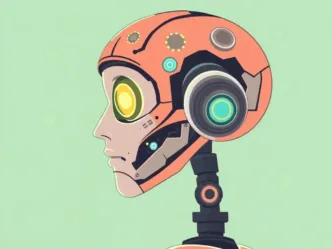Explore Agentic AI vs AI Agents key differences & future of intelligent systems. Understand how they shape automation, decision-making, & AI evolution.
Agentic AI vs AI Agents: A Comprehensive Comparative Analysis
Introduction
In the rapidly evolving field of artificial intelligence, the terms “AI agents” and “agentic AI” have emerged as significant concepts, often used interchangeably but representing distinct levels of autonomy, functionality, and complexity. As organizations increasingly adopt AI to enhance efficiency and innovation, understanding the differences between these paradigms is essential for selecting the appropriate technology for specific applications. AI agents are individual software programs designed to perform targeted tasks, while agentic AI encompasses advanced systems that operate autonomously to achieve complex goals, often by coordinating multiple agents.
This article provides a formal and comprehensive examination of AI agents and agentic AI, detailing their definitions, operational frameworks, key technologies, applications, benefits, challenges, and a comparative analysis. It aims to equip professionals and organizations with a thorough understanding of these concepts to facilitate informed decision-making in 2025.
Definitions
AI Agents
An AI agent is a software program designed to autonomously perform specific tasks on behalf of a user or another system, typically following predefined rules or algorithms. These agents operate within defined parameters, leveraging technologies such as natural language processing or machine learning to execute functions like answering queries or automating routine processes.
According to industry sources, AI agents encompass a broad range of functionalities, from simple rule-based systems to more complex models that incorporate limited learning capabilities. They are typically task-specific, requiring human input or guidance to function effectively, and their autonomy is constrained by their predefined scope.
Agentic AI
Agentic AI refers to advanced AI systems that exhibit a high degree of autonomy, capable of independently pursuing complex goals through decision-making, learning, and adaptation. The term “agentic” derives from the concept of agency, emphasizing the system’s ability to act purposefully without constant human oversight.
Agentic AI often operates within a multi-agent framework, where an orchestrator coordinates multiple AI agents to achieve a broader objective. These systems leverage sophisticated reasoning, iterative planning, and continuous learning to adapt to dynamic environments, making them suitable for intricate workflows.
Operational Frameworks
AI Agents Framework
AI agents operate within a structured framework designed to execute specific tasks efficiently. The core components include:
- Perception: Agents collect data from their environment, such as user inputs or system data, to inform their actions.
- Processing: Using rule-based algorithms or trained models, agents process data to generate appropriate responses or actions.
- Execution: Agents perform tasks, such as answering a query or updating a database, within their designated scope.
- Limited Learning: Most agents have minimal learning capabilities, relying on static rules or pre-trained models without significant adaptation.
Key technologies include NLP for conversational tasks, basic ML for pattern recognition, and rule-based systems for deterministic actions. For example, a customer service chatbot processes queries using NLP and responds based on a predefined knowledge base, operating as an AI agent with limited autonomy.
Agentic AI Framework
Agentic AI operates within a multi-agent system, where an orchestrator coordinates specialized AI agents to achieve complex objectives. The framework includes:
- Task Decomposition: The orchestrator breaks down complex goals into manageable subtasks, identifying dependencies and priorities.
- Agent Selection: Tasks are assigned to agents based on their expertise, such as data analysis or natural language understanding.
- Coordination: The orchestrator manages the sequence and dependencies of tasks, ensuring seamless collaboration among agents.
- Monitoring and Adjustment: The system tracks agent performance, reassigning tasks or implementing corrective actions as needed.
- Result Integration: Outputs from individual agents are combined to produce a unified final result.
Key technologies include machine learning, NLP, reinforcement learning (RL), deep learning, and multimodal learning, enabling agentic AI to handle diverse data types and dynamic environments. For instance, an autonomous supply chain system uses RL to learn optimal inventory management strategies based on real-time data.
Key Technologies
The following table summarizes the technologies underpinning AI agents vs agentic AI:
| Technology | AI Agents | Agentic AI |
|---|---|---|
| Machine Learning 🤖 | Basic ML for pattern recognition | Advanced ML for decision-making and adaptation |
| Natural Language Processing 🗣️ | Enables conversational tasks | Supports complex interactions and reasoning |
| Reinforcement Learning 🎯 | Limited use for task optimization | Critical for learning optimal actions through feedback |
| Deep Learning 🧠 | Used in complex agents for specific tasks | Processes complex datasets for goal-driven outcomes |
| Multimodal Learning 🌐 | Rare, limited to specific applications | Integrates text, images, and audio for comprehensive tasks |
These technologies reflect the broader capabilities of agentic AI compared to the more focused scope of AI agents.
Comparative Analysis
The primary distinction between AI agents vs agentic AI lies in their scope, autonomy, and complexity. The following table compares their key characteristics:
| Aspect | AI Agents | Agentic AI |
|---|---|---|
| Scope | Task-specific, focused functions | Broad, multi-step workflows |
| Autonomy | Limited, often requires human input | High, operates independently |
| Complexity | Simple to moderately complex tasks | Complex, end-to-end processes |
| Learning | Minimal learning capabilities | Advanced learning and adaptation |
| Examples | Chatbots 🤖, recommendation systems 🛒 | Autonomous customer service 💼, self-driving cars 🚗 |
Scope and Functionality
AI agents are designed for specific, well-defined tasks, such as answering customer queries or recommending products. They operate within a narrow scope, often relying on predefined rules or limited learning capabilities. Agentic AI, conversely, manages complex, multi-step processes by coordinating multiple agents, enabling end-to-end solutions like autonomous supply chain management or intelligent customer relationship systems.
Autonomy
AI agents typically exhibit limited autonomy, requiring human prompts or guidance to function effectively. For example, a chatbot may need a user query to initiate a response. Agentic AI systems, however, operate with high autonomy, setting sub-goals, making decisions, and adapting to new information without constant oversight. This autonomy enables agentic AI to handle dynamic environments, such as real-time logistics optimization.
Complexity
AI agents are suited for straightforward tasks, such as scheduling appointments or filtering emails. Agentic AI tackles intricate workflows, integrating multiple agents to achieve broader objectives.
Learning and Adaptation
While some AI agents incorporate basic learning, their adaptability is limited compared to agentic AI, which leverages reinforcement learning and deep learning to continuously improve performance. Agentic AI systems learn from feedback, refine their strategies, and adapt to dynamic conditions, making them more robust for complex applications.
Applications
The distinct capabilities of AI agents and agentic AI lead to varied applications across industries:
AI Agents
- Customer Support Chatbots 📞: Handle routine inquiries, such as answering FAQs or troubleshooting issues, using NLP to provide predefined responses.
- Recommendation Systems 🛒: Suggest products or content based on user history, as seen in e-commerce platforms like Amazon.
- Virtual Assistants 📅: Perform tasks like setting reminders or playing music, exemplified by Siri or Alexa.
Agentic AI
- Autonomous Vehicles 🚗: Navigate roads, make real-time decisions, and learn from driving experiences using multiple AI agents.
- Supply Chain Optimization 📦: Autonomously manage inventory, predict demand, and optimize logistics by integrating data from multiple sources.
- Cybersecurity 🔒: Detect and respond to threats in real time, coordinating agents for network analysis and mitigation.
- Healthcare 🩺: Predict patient outcomes and recommend treatments, learning from medical data.
Benefits
Both paradigms offer distinct advantages:
- AI Agents:
- Efficiency in Specific Tasks: Quickly perform well-defined functions, reducing manual effort.
- Ease of Implementation: Simple to deploy for targeted applications, requiring minimal setup.
- Cost-Effectiveness: Suitable for small-scale tasks, minimizing resource demands.
- Agentic AI:
- High Autonomy: Operates independently, reducing the need for human oversight.
- Complex Workflow Management: Handles end-to-end processes, improving efficiency by up to 40% in multi-agent systems.
- Adaptability: Learns and adjusts to dynamic environments, ensuring robust performance.
Challenges
Both paradigms present unique challenges:
- AI Agents:
- Limited Scope: Cannot handle tasks outside their programming, restricting versatility.
- Dependence on Human Input: Often requires prompts or guidance, reducing autonomy.
- Scalability Issues: May struggle with large-scale applications without integration into broader systems.
- Agentic AI:
- System Complexity: Development and maintenance are resource-intensive, requiring significant expertise.
- Ethical Concerns: Autonomous decision-making raises issues of bias and accountability.
- Computational Demands: Require substantial resources for coordination and learning.
Emerging Trends
In 2025, the field of AI agents and agentic AI is evolving with technological advancements:
- Advanced Algorithms 🤖: Improved machine learning and reinforcement learning will enhance the autonomy and accuracy of both AI agents and agentic AI.
- Multi-Agent Systems 🌐: Increasing integration of AI agents into agentic AI frameworks will enable more complex, end-to-end solutions.
- Ethical AI Development 📜: Growing focus on addressing bias and ensuring accountability in autonomous systems.
- No-Code Platforms 📚: Tools enabling non-technical users to build AI agents and agentic systems will broaden accessibility.
- Hybrid Models 🔄: Combination of AI agents and agentic AI in unified platforms will leverage the strengths of both for comprehensive solutions.
Conclusion
AI agents and agentic AI represent distinct yet interconnected paradigms within the field of artificial intelligence. AI agents are specialized tools designed for specific tasks, offering efficiency and ease of implementation but limited autonomy. Agentic AI, as an advanced subset of AI agents, integrates multiple agents to autonomously manage complex workflows, demonstrating high autonomy, adaptability, and decision-making capabilities.
Understanding their differences is crucial for selecting the appropriate technology for specific applications, whether automating simple tasks with AI agents or tackling dynamic processes with agentic AI. As the field evolves in 2025, hybrid models combining both paradigms will likely emerge, offering balanced solutions for diverse applications. By leveraging their advantages and addressing their challenges, organizations can harness these technologies to drive innovation, efficiency, and growth.
Note: This article is for informational purposes only and not professional advice. Verify specific applications and technologies before adopting AI solutions.







